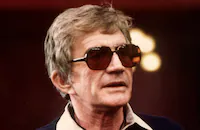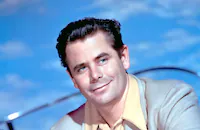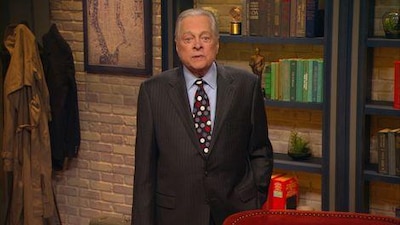Experiment in Terror

Brief Synopsis
Cast & Crew
Blake Edwards
Glenn Ford
Lee Remick
Stefanie Powers
Ross Martin
Roy Poole
Film Details
Technical Specs

Synopsis
Late one evening, San Francisco bank teller Kelly Sherwood is seized in the garage of her home by an asthmatic stranger who warns her that unless she steals $100,000 from the bank where she works, he will kill either her or her younger sister, Toby, or both of them. Terrified, Kelly communicates with FBI agent John Ripley, who advises her to pretend to cooperate with the stranger while he and the police investigate. Official inquiries identify the man as Red Lynch, an ex-convict wanted for murder. Ripley tries to enlist the help of Lynch's current girl friend, Lisa Soong, who refuses to cooperate, because Lynch has paid heavy medical expenses for her crippled son. By tracing the purchase of a toy Lynch bought for the child, Ripley is able to discover where Lynch is holding Toby prisoner. On the day arranged for the theft, Kelly steals the $100,000 and follows Lynch's instructions by carrying the money to Candlestick Park, where a baseball game is in progress. As the game ends and Lynch tries to grab the purse from Kelly, Ripley pounces on him. Although Lynch manages to break away and fight his way through the crowd to the deserted playing field, he is shot down by Ripley as hordes of police pour down the aisles.

Director

Blake Edwards
Cast

Glenn Ford

Lee Remick

Stefanie Powers
Ross Martin
Roy Poole
Ned Glass
Anita Loo
Patricia Huston
Gilbert Green
Clifton James
Al Avalon
William Bryant
Dick Crockett
James Lanphier
Warren Hsieh
Sidney Miller
Clarence Lung
Frederic Downs
Sherry O'neil
Mari Lynn
Harvey Evans
William Sharon
Crew
Betty Abbott
James M. Crowe
Lambert Day
Blake Edwards
Blake Edwards
The Gordons
Jack Hayes
Ben Lane
Philip Lathrop
Henry Mancini
Patrick Mccormack
Sam Nelson
Don Peters
Robert Peterson
Charles J. Rice
Leo Shuken

Photo Collections
Videos
Movie Clip




Hosted Intro



Film Details
Technical Specs

Articles
Experiment in Terror
The film boasts one of the most memorable opening scenes of any thriller: Kelly Sherwood (Lee Remick), an attractive single woman living in the suburbs of San Francisco, drives home from her job as a bank teller. After getting out of her Ford Fairlane convertible, she becomes aware of another person waiting for her in the dark of the garage; she hears a heavy asthmatic wheeze in his voice. The man grabs her from behind and, disturbingly, tells her, "I know a good deal about you, almost everything there is to know," and to prove it he recites her measurements. The stranger gives Kelly explicit instructions to steal $100,000 from her bank or he will kill her and her younger sister Toby (Stefanie Powers). The stranger also tells her not to go to the police. Kelly never sees her assailant - he is "Red" Lynch (Ross Martin), a psychopath fully capable of carrying out his threats. Kelly is terrified, but ignores the threats and contacts the F.B.I. Agent John Ripley (Glenn Ford) gets the case and advises Kelly while the agency monitors her calls and actions and attempts to protect the sisters. While Lynch threatens and toys with Kelly by telephone, Ripley investigates and runs into local characters such as Lynch's girlfriend Lisa Soong (Anita Loo), street informant "Popcorn" (Ned Glass), and another of Lynch's female victims, Nancy Ashton (Patricia Huston). Despite the F.B.I. surveillance, Kelly never feels secure, even among the huge crowd at a ballgame at Candlestick Park, scene of the film's climax.
With Experiment in Terror Blake Edwards presents a thriller with a refreshing take on the leading characters - the "victim" is properly terrified, but she is also very intelligent and determined to avoid becoming victimized. The F.B.I. agent "protecting" Kelly and her sister realistically knows that he can't guarantee total protection from a psychopath. In their book, Blake Edwards, Peter Lehman and William Luhr observe that the villainy of "Red" Lynch, following the initial assault in the garage, also comes in a new and different form. "The perverse pleasure we see him experience in the film comes not from voyeurism - watching from some proximate yet concealed space - but rather from a particularly modern kind of experience - intruding upon a person's privacy by means of the telephone. ...He could be in the next room or across the city. He calls her at home and on the job and derives pleasure from her terror." Perhaps the most refreshing story aspect in Experiment in Terror is that both Kelly and agent Ripley are single, yet there is not a shred of Hollywood romance forced on them. Given the absence of a romantic angle, Edwards is free to balance the film between sharp character studies and a series of clever visual set pieces.
Contemporary reviews of Experiment in Terror were mostly positive. Paul V. Beckley, writing in the New York Herald Tribune, offered a rave, saying that "Blake Edwards, whose direction of Breakfast at Tiffany's gave no evidence of such an exhilarating talent for the suspense genre, here gives every sign of having one of the sharpest directorial minds in the immediate vicinity." Newsweek magazine called the film "a quinky, juberous movie that could scare the gizzard out of a gorilla," and said that "the casting in this is adroit. Actor Ford quietly radiates assurance that he will do everything in his power to save Miss Remick, but there is obviously a chance that his power won't suffice. Miss Remick is probably the only actress extant who can look at once terrified and sassy, and her juggling of these contrary emotions is nerve-racking."
Some critics faulted the film for its running time, at just over two hours. Newsweek is positive in their review, but adds, "the movie runs on much too long before winding up with a Hitchcockeyed shoot-out in Candlestick Park..." while Bosley Crowther in the New York Times has praise for the director and cast, but ends by saying "it takes more than two hours to come to a solution of the problem in this film. They would do it in one hour on TV, and it would probably be every bit as good."
Whether Experiment in Terror qualifies as a latter-day film noir or not is debatable. The editors of Film Noir: An Encyclopedic Reference to the American Style feel it does, and Jonathon Benair writes, "the heroine is surrounded by people but is still very alone, defenseless, and vulnerable to attack from the criminal who has singled her out as his prey. She is most susceptible in the place that people normally feel most secure: her home. Additionally, although her dangerous position is known by the F.B.I., their plans leave her unprotected. In film noir's urban landscape, one is safe nowhere." Benair also mentions the wheezing voice of the villain, noting that "heavies in film noir often have distinct physical deformities, such as Everett Sloane's limp in The Lady from Shanghai [1947], or vivid mannerisms, such as Richard Widmark's high-pitched giggle in Kiss of Death [1947], to correspond to their tainted souls."
Ross Martin gives a chilling, memorable performance as the wheezing psychopath "Red" Lynch. His name was kept off of the movie's opening credits and publicity material, but he was rewarded instead with a showy solo end credit. Martin was born in Poland but raised in New York City; he was fluent in Polish, Russian, and Yiddish before learning to speak English. He became a familiar supporting player on television beginning in 1951, taking time out for parts in two science-fiction features of the decade, Conquest of Space (1955) and The Colossus of New York (1958). He played sidekick to the title character in the TV series Mr. Lucky (1959-1960), and appeared in scattered episodes of many high-profile 1960s series, including Bonanza, The Twilight Zone, and the Blake Edwards-produced Peter Gunn. Following Experiment in Terror, Martin appeared in Edwards' epic comedy feature The Great Race (1965), but otherwise stuck to series television, scoring his best known role as 19th century secret agent Artemus Gordon in The Wild Wild West (1965-1969), starring Robert Conrad. A heart condition kept Martin from playing lead roles beyond that series, although he kept busy until his death in 1981.
As he had previously with Peter Gunn and Breakfast at Tiffany's, Blake Edwards once again called on Henry Mancini to write the musical score for Experiment in Terror. Mancini produced some memorable moments, in particular a theme for villain "Red" Lynch featuring eerie chords plucked on an autoharp. While no top forty hit was culled from Experiment in Terror's soundtrack like there had been with Edward's previous film Breakfast at Tiffany's with its popular song "Moon River," the main theme for the thriller was nonetheless soon covered by instrumental rock band The Champs, and has been reinterpreted by many surf, lounge, and exotica bands in the years since, including Laika and the Cosmonauts, Impala, Davie Allan and The Arrows, The Blue Hawaiians, and many others.
Producer: Blake Edwards
Director: Blake Edwards
Screenplay: Gordon Gordon, Mildred Gordon (screenplay and novel "Operation Terror"; credited as The Gordons
Cinematography: Philip H. Lathrop
Art Direction: Robert Peterson
Music: Henry Mancini
Film Editing: Patrick McCormack
Cast: Glenn Ford (John 'Rip' Ripley), Lee Remick (Kelly Sherwood), Stefanie Powers (Toby Sherwood), Roy Poole (Brad), Ned Glass (Popcorn), Anita Loo (Lisa), Patricia Huston (Nancy Ashton), Gilbert Green (Special agent), Clifton James (Capt. Moreno), Al Avalon (Man who picked up Kelly), William Bryant (Chuck), Ross Martin (Garland Humphrey "Red" Lynch)
BW-124m. Letterboxed. Closed Captioning.
by John M. Miller

Experiment in Terror
Experiment in Terror on Blu-ray
Kelly quickly involves the FBI, and agent John Ripley (Glenn Ford) takes the case. From then on, director Blake Edwards retreats from the subjective presentation of aligning us with Kelly and instead opts for an objective point of view, allowing us to peer in on an assortment of characters as they deal with the unfolding narrative. Edwards also gives us high-angle shots of the action at key moments, building suspense from our knowledge of all the many pieces of the story puzzle. In that sense, it is an "experiment" on manipulating audience response and creating tension by means of careful release of visual information.
That calculated approach could well have resulted in a cold and analytical film, but Experiment in Terror maintains an emotional interest due to characters we are made to care about, primarily Lee Remick. She was a very talented beauty who had recently impressed in Anatomy of a Murder (1959) and Wild River (1960), and would be Oscar-nominated for another Blake Edwards film of 1962, Days of Wine and Roses.
Experiment in Terror functions as a late-cycle film noir due to its brooding sense of danger in every corner of the city, and for its magnificent black-and-white cinematography by Philip Lathrop, who achieves what must be the blackest blacks possible. The frame is often so dominated by blackness that that in itself effectively creates the movie's incredibly consistent sense of foreboding and dread. The ominous score by Henry Mancini also contributes, especially his imaginative use of a reverberating autoharp and an electronic undertone. And yet another factor is Edwards' use of direct cuts designed for shock effect, with bursts of music, loud sounds, and sometimes extreme close-ups punctuating the cuts.
Experiment in Terror stands out as a seemingly unusual entry on Blake Edwards' filmography, as he is best remembered as the director of numerous Pink Panther films and many more hit comedies. But Edwards was also extremely capable in other genres, making serious dramas, romantic dramas, suspense films, musicals and a western at various points of his career. Even Edwards' comedies contain suspense scenes in their own ways -- sometimes with a comedic tone, and sometimes as straight suspense sequences, as in the Pink Panther films when we watch the diamond being stolen. It's a reminder of how closely related comedy and suspense really are.
This picture followed by a few months the release of Cape Fear (1962), a similar film in which Gregory Peck and his family are terrorized by Robert Mitchum. Both movies probably owe some of their existence to the game-changing Psycho (1960). In any event, Experiment in Terrorholds its own as a superb and visually beautiful piece of suspense, and it has been very well-served by its presentation on Blu-ray from Twilight Time, with a rock-steady image and its stunning blacks perfectly transferred. In addition, the great use of San Francisco locations, from many corners of the city, come off as quite vivid and full of wonderful texture.
Twilight Time's Blu-ray is limited to 3000 copies and includes an isolated score track and several theatrical trailers and television ads for the film, all of which made a big point of keeping the identity of the villain a secret. Julie Kirgo's liner notes are informative and scholarly. A highly recommended release.
For more information about Experiment in Terror, visit Twilight Time at Screen Archives Entertainment.
By Jeremy Arnold
Experiment in Terror on Blu-ray
Quotes
Trivia
Notes
Filmed on location in San Francisco.

Miscellaneous Notes
Released in United States 2000
Released in United States Spring April 13, 1962
Completed shooting November 11, 1961.
An FBI agent is drawn into an extortion scheme in which a crazed psychopath holds a woman hostage in her garage in order to get her to withdraw money for him.
Released in United States 2000 (Shown in New York City (Film Forum) as part of program "Neo Noir" February 18 - April 6, 2000.)
Released in United States Spring April 13, 1962













